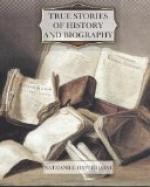“And was she executed?” asked Laurence.
“She was,” said Grandfather.
“Grandfather,” cried Charley, clenching his fist, “I would have fought for that poor Quaker woman!”
“Ah! but if a sword had been drawn for her,” said Laurence, “it would have taken away all the beauty of her death.”
It seemed as if hardly any of the preceding stories had thrown such an interest around Grandfather’s chair, as did the fact, that the poor, persecuted, wandering Quaker woman had rested in it for a moment. The children were so much excited, that Grandfather found it necessary to bring his account of the persecution to a close.
“In 1660, the same year in which Mary Dyer was executed,” said he, “Charles the Second was restored to the throne of his fathers. This king had many vices; but he would not permit blood to be shed, under pretence of religion, in any part of his dominions. The Quakers in England told him what had been done to their brethren in Massachusetts; and he sent orders to Governor Endicott to forbear all such proceedings in future. And so ended the Quaker persecution,—one of the most mournful passages in the history of our forefathers.”
Grandfather then told his auditors, that, shortly after the above incident, the great chair had been given by the mint-master to the Rev. Mr. John Eliot. He was the first minister of Roxbury. But besides attending to his pastoral duties there, he learned the language of the red men, and often went into the woods to preach to them. So earnestly did he labor for their conversion, that he has always been called the apostle to the Indians. The mention of this holy man suggested to Grandfather the propriety of giving a brief sketch of the history of the Indians, so far as they were connected with the English colonists.
A short period before the arrival of the first Pilgrims at Plymouth, there had been a very grievous plague among the red men; and the sages and ministers of that day were inclined to the opinion, that Providence had sent this mortality, in order to make room for the settlement of the English. But I know not why we should suppose that an Indian’s life is less precious, in the eye of Heaven, than that of a white man. Be that as it may, death had certainly been very busy with the savage tribes.
In many places the English found the wigwams deserted, and the corn-fields growing to waste, with none to harvest the grain. There were heaps of earth also, which, being dug open, proved to be Indian graves, containing bows and flint-headed spears and arrows; for the Indians buried the dead warrior’s weapons along with him. In some spots, there were skulls and other human bones, lying unburied. In 1633, and the year afterwards, the smallpox broke out among the Massachusetts Indians, multitudes of whom died by this terrible disease of the old world. These misfortunes made them far less powerful than they had formerly been.




